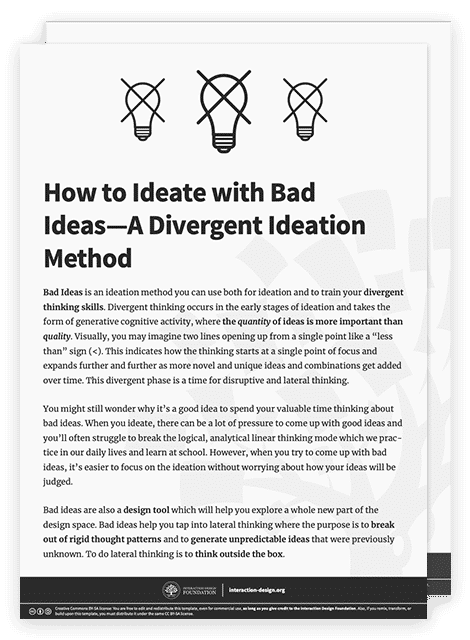Video copyright info
- Images
- Copyright holder: William Heath Robinson. Appearance time: 1:30 - 1:33 Copyright license and terms: Public domain. Link: https://upload.wikimedia.org/wikipedia/commons/c/c9/William_Heath_Robinson_Inventions_-_Page_142.png
- Copyright holder: Rev Stan. Appearance time: 1:40 - 1:44 Copyright license and terms: CC BY 2.0 Link: As yummy as chocolate teapot courtesy of Choccywoccydoodah… _ Flickr.html
- Copyright holder: Fabel. Appearance time: 7:18 - 7:24 Copyright license and terms: CC BY-SA 3.0 Link: https://commons.wikimedia.org/wiki/File:Hammer_nails_smithonian.jpg
- Copyright holder: Marcus Hansson. Appearance time: 05:54 - 05:58 Copyright license and terms: CC BY 2.0 Link: https://www.flickr.com/photos/marcus_hansson/7758775386
Sometimes, the pressure to come up with a good idea can make you completely stuck in your ideation. Your critical sense gets the better of you, and all your ideas seem like bad ones. What if instead of trying to think of a good idea you deliberately set out to think up a bad idea or a silly one? In this video, you learn to use the ideation method “Bad Ideas” and see how thinking up, analyzing and tinkering with bad ideas can be a great way to gain new insights and even ultimately lead to new good ideas!
Bad Ideas is an ideation method you can use both for ideation and to train your divergent thinking skills.
Divergent Thinking
Divergent thinking occurs in the early stages of ideation and takes the form of generative cognitive activity, where the quantity of ideas is more important than the quality. Visually, you may imagine two lines opening up from a single point like a “less than” sign (<). This indicates how the thinking starts at a single point of focus and expands further and further as more novel and unique ideas and combinations get added over time. This divergent ideation phase is a time for disruptive, horizontal and lateral thinking.
You might still wonder why it’s a good idea to spend your valuable time thinking about bad ideas. When you ideate, there can be a lot of pressure to come up with good ideas, and you’ll often struggle to break the logical, analytical linear thinking mode which we practice in our daily lives and learn at school. However, when you try to come up with bad ideas, it’s easier to focus on the ideation without worrying about how your ideas will be judged.
Bad ideas are also a design tool which will help you explore a whole new part of the design space. Bad ideas help you tap into lateral thinking—where the purpose is to break out of rigid thought patterns and to generate unpredictable ideas that were previously unknown. Lateral thinking is thinking outside the box.
Bad ideas obviously start out as bad; however, if you follow the steps in the ideation method template below, it’s also an amazing method for coming up with good ideas!
Download our Bad Ideas Template and Start Ideating Now
We’ll guide you through the 4 steps in the Bad Ideas method.





